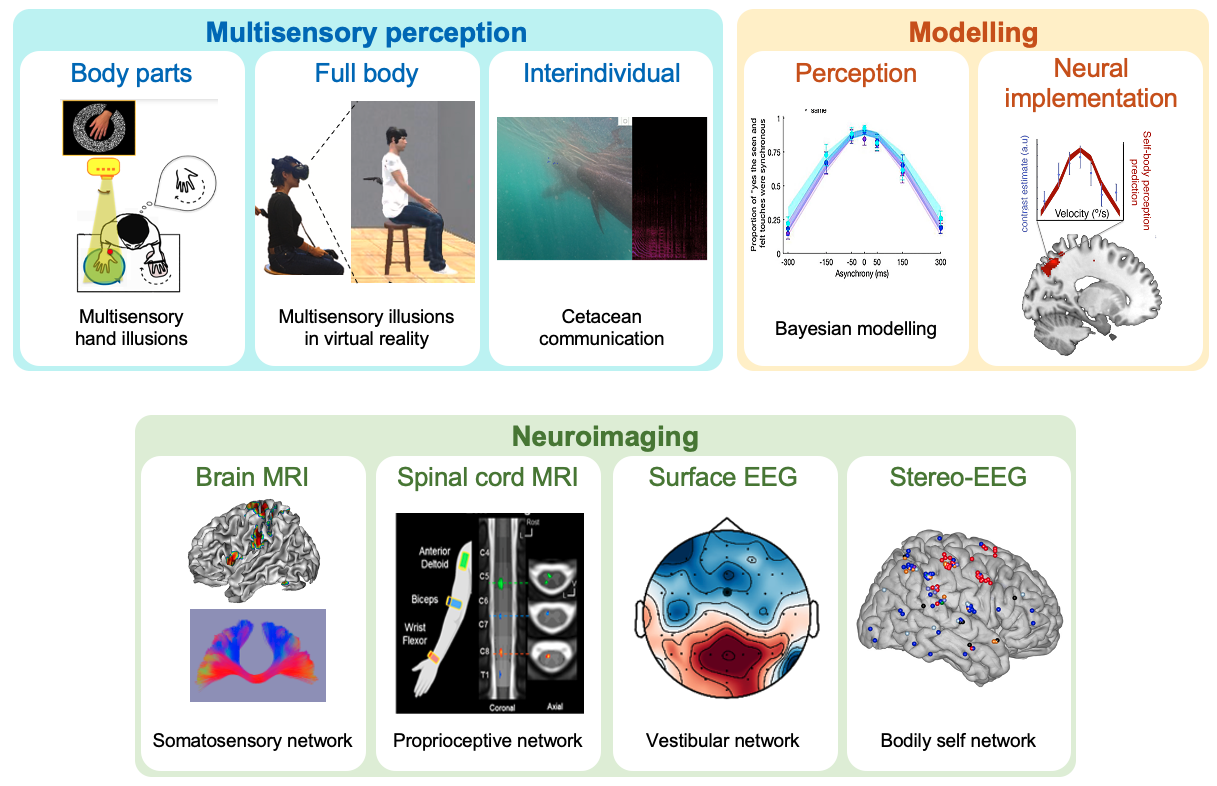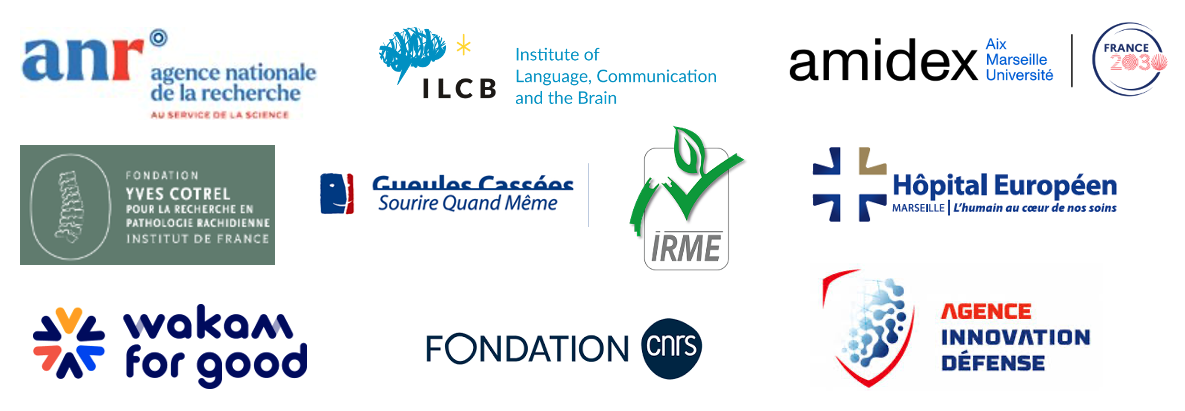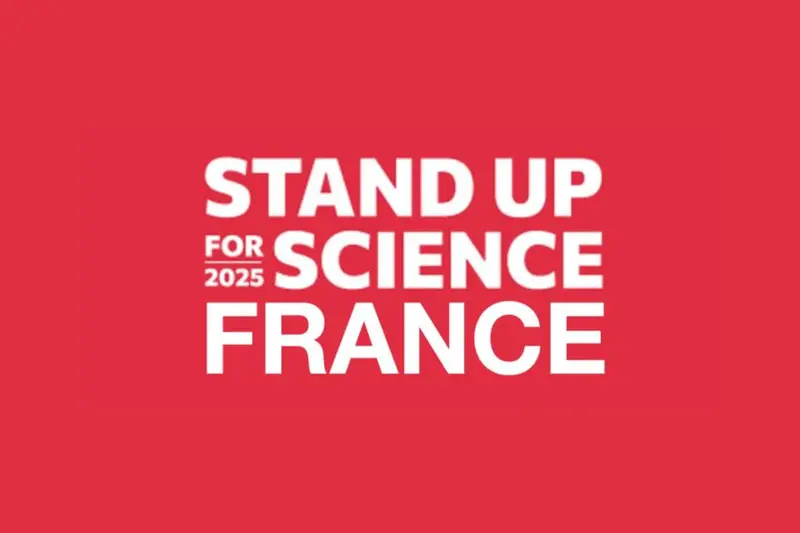
MULTISENSE & BODY is a multidisciplinary team that explores how sensory signals from the proprioceptive, vestibular, and visual systems shape the sense of one’s own body, the perception of self-motion and influence the building of language/communication from a developmental and phylogenetic perspective.
We study how these bodily experiences change – and how the brain adapts – after sensory disruptions (e.g., amputation, vestibular deficits) and during aging in humans.
We also investigate how body signals and motor planification contribute to cognition, self-consciousness, language in humans, and communication in non-human animals.
Our research combines multidisciplinary methods, including:
- Electrophysiology (EMG, EEG, stereo-EEG)
- Neuroimaging of the brain and spinal cord (MRI, spectroscopy, diffusion imaging)
- Behavioral and psychophysical testing (multisensory stimulation, body illusions, virtual reality, language and motor tasks)
- Computational modelling including deep learning networks accounting for neural and behavioral data
- Ethological observations and bioacoustics recordings of multimodal communication in non-human animals (non-human primates and cetaceans)
Keywords: proprioception, vestibular system, touch, human movement, balance, bodily self, multisensory integration, neuroimaging, modeling, brain plasticity, aging, language, non-human animal communication.

Ongoing projects
Project SPINAL CORD: Mapping the human projectome and its interindividual variability. Using spinal fMRI during localised muscle vibration, this project aims to reveal the organization of propriomotor circuits in healthy individuals and how these spinal circuits functionally reorganise after limb amputation (collaboration: Prof P. Giraux and H. Bessaguet, CHU Saint-Étienne; Dr L. Théfenne, Hôpital Lavéran) or complete spinal cord transection (collaboration: Prof G. Courtine, EPFL). PI: A. Kavounoudias
Project PHANTOMPAIN: Exploring phantom limb pain through three axes: (1) Alterations in sensorimotor brain and spinal networks after amputation; (2) Links between these changes and phantom pain; (3) A novel rehabilitation method using proprioceptive stimulation to induce movement illusions of the missing limb. (Collaborations: Dr L. Théfenne, Hôpital Lavéran; Dr P. Giraux, Dr H. Bessaguet, CHU Saint-Étienne). PI: A. Kavounoudias
Project VESTISELF: Bridging vestibular physiology and the cognitive neuroscience of the self. We investigate the vestibular and multisensory foundations of bodily self-consciousness through multisensory illusions in neurotypical participants and patients with vestibular disorders (collaboration: Dr M. Elzière, Hôpital Européen). We also study self-related and vestibular brain networks in epileptic patients using stereo-EEG (collaboration: Prof F. Bartolomei, APHM, INS). PI: C. Lopez
Project PERSOCOR: A large-scale study of self-experience in vestibular disorders. Using psychometric tools, we assess how often patients experience self-disturbances (e.g., depersonalization-derealization) and which etiologies carry the highest risk (collaboration: Dr M. Elzière, Hôpital Européen). PI: C. Lopez
Project MULTISELF: Integrating all components of self-body perception by quantitatively modeling the emergence of sensory illusions with supporting cerebral activity. Our goal is to unravel the complex dynamic between the components of self-body perception at both the behavioral and cerebral levels. By leveraging novel behavioral paradigms, computational modeling, and neuroimaging, we seek to understand how we perceive our body as a unified entity and still adapt to its dynamic changes. PI: M. Chancel
Project SELF-I-LUP: Bodily-self perception in auto-immune diseases: proof of concept in Lupus patients. In autoimmune diseases like Lupus, the immune system appears to treat the self-body or body parts as foreign, as external to the self. We investigate whether such “immune disownership” appears in self-related sensory and non-sensory information. (collaborations: Dr L. Chiche, Hôpital Européen). PI: M. Chancel
Project MOTOR & LANGUAGE SYNTAX: Language and motor actions might share common neurobiological domain-general processes that are involved in fine-grained motor planification for language syntax and syntactic-like sequences of manual actions. We investigate learning transfer between language and motor syntax in adults and children using behavioral tasks and fMRI (collaborations: M.H. Grosbras, CRPN; C. Brozzoli, Univ. Lyon). PI: M. Montant
Project CETACEANS COMMUNICATION: This project aims at comparing human language to other complex animal communication systems, namely those of cetaceans (pilot whales). Using underwater videos, bioacoustics recordings, ethological methods and machine-learning analyses, we study pilot whale's multimodal (audio-tactile-postural) communication (collaborations: T. Legou, LPL AMU, R. Marxer, LIS AMU, F. Delfour, Ecole Nationale Vétérinaire de Toulouse). PI: M. Montant
Project AGING: Identifying predictive markers of aging and mapping individual multisensory profiles. Older adults complete vestibular, visual, tactile, and proprioceptive tests, alongside structural and functional MRI. Machine-learning algorithms are applied to integrated psychophysical, neurophysiological, and imaging data to uncover key patterns and predictors. All team PIs are involved.
Funding bodies

Alumni (PhD and postdoc supervised by current team members)
- BLANCHARD Caroline, research fellow at the University of Nottingham, UK
- CARON-GUYON Jeanne, assistant professor at Grenoble Alpes University, France
- CHANCEL Marie, researcher at CNRS in Marseille (CRPN), France
- CORBO Julien, research fellow at NYU, USA
- DARY Zoé, postdoc at Harvard Medical School, USA
- DEROUALLE Diane, data scientist, France
- GRASSO Camille, postdoc at Grenoble Alpes University, France
- LANDELLE Caroline, postdoc at McGill University, Canada
- MELETAKI Vasiliki, postdoc at University of Pennsylvania, USA
- NAKUL Estelle, CEO Gulliver, France
- PAVLIDOU Anastasia, postdoc at Bern University, Switzerland
- SEROPIAN Lou, data scientist, France

